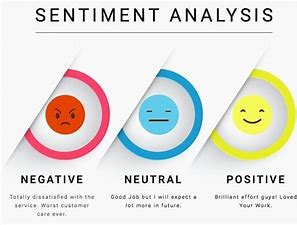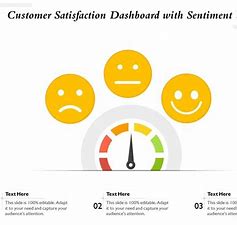Information about Sentiment scoring?

Algorithm that assess the tone of a transcript on a spectrum of positive towards negavtive.it includes over all score and delta. The document level score is in the ratio of positive and negative statement from the entire call a 100 score minus of 100 with the zero to being neural.
The delta shows the difference in overall sentiment since the previous quarter earning for that company.
Overall score -18
change (delta) 35%
DATE 2021-14
Sentiment scoring is a valuable tool in natural language processing that helps analyze and quantify the emotional tone expressed in text. This article explores the concept of sentiment scoring, its applications, methodologies, and the impact it has on various industries, from marketing and customer feedback analysis to social media monitoring and sentiment analysis.
What is Sentiment Scoring?
Sentiment scoring involves assigning a numerical value or score to text, indicating the sentiment or emotional tone expressed within it. It aims to capture sentiments such as positive, negative, or neutral, enabling the quantification and analysis of emotional content. Sentiment scoring algorithms employ various techniques, including lexical analysis, machine learning, and deep learning, to interpret the sentiment of words, phrases, or entire documents.
Applications of Sentiment Scoring
Sentiment scoring has numerous practical applications across industries. In marketing, sentiment analysis helps gauge customer opinions, assess brand perception, and identify trends or issues. Customer feedback analysis utilizes sentiment scoring to understand customer satisfaction levels and detect areas for improvement. Social media monitoring platforms use sentiment scoring to track public opinion, assess brand sentiment, and identify emerging trends or crises. Financial institutions employ sentiment analysis to gauge market sentiment and make informed investment decisions.
Methodologies and Challenges
Sentiment scoring methodologies vary depending on the complexity of the analysis required. Lexical-based approaches assign scores to individual words or phrases based on pre-defined sentiment lexicons. Machine learning techniques utilize labeled training data to build models that can predict sentiment based on input features. Deep learning methods leverage neural networks to capture complex patterns and nuances in text sentiment. Challenges in sentiment scoring include sarcasm or irony detection, context sensitivity, handling language nuances, and cultural variations in expressing sentiment.
Limitations and Ethical Considerations
Sentiment scoring is not without limitations. It may struggle with accurately interpreting context or understanding subtle nuances of sentiment. Ambiguity in language and cultural differences can also pose challenges. Additionally, ethical considerations arise regarding privacy, bias, and the responsible use of sentiment analysis techniques, particularly when applied to sensitive data or social media content.
Sentiment scoring provides a valuable means of quantifying and analyzing emotional tone in text. With its wide range of applications and methodologies, sentiment scoring enables businesses to gain insights into customer opinions, public sentiment, and market trends. However, it is crucial to address its limitations and ethical considerations to ensure responsible and effective use in various domains.
HOW TO CALCULATE SENTIMENT SCORE
For this we have a specific document, first entails counting the raw output.
That counting includes.
. Overall negative statement in the document
overall positive statement in the document
total no. Of statement in the document
the raw system drives the raw sentiment score. The normalize statement score.
This is the raw score which across all the companies such that the mean sentiment is 0 and the score are in between -99 to 99.
Each sentence gives transcript gives a guess of positive and negative or neural.
For the DOC level we must take the positive statement -the count of negative and then divided by the overall statements.
We can normalize these score by the confidence of every prediction and the mean and standard deviation of score across all transcript ion the previous years. Such that overall score is 0.
in easy way to count the sentiment score each positive word count as +1 and negative word count is -1……………..
Calculating sentiment scores is a fundamental aspect of sentiment analysis, enabling the quantification of emotions expressed in text. This article explores various methods and approaches used to calculate sentiment scores, including lexicon-based approaches, machine learning techniques, and hybrid models. By understanding these methodologies, businesses can extract valuable insights from textual data.
Lexicon-Based Approaches
Lexicon-based approaches assign sentiment scores based on pre-constructed sentiment lexicons or dictionaries. Each word in the text is matched to entries in the lexicon, and sentiment scores are assigned accordingly. Simple lexicons may assign binary scores (positive or negative), while more comprehensive ones may provide a range of intensity scores. Aggregation techniques, such as counting the number of positive and negative words, can be used to calculate an overall sentiment score for the text.
Machine Learning Techniques
Machine learning techniques involve training models on labeled datasets to learn patterns and predict sentiment. Supervised learning algorithms, such as Support Vector Machines (SVM) or Naive Bayes, are commonly used for sentiment classification. Features such as word frequencies, n-grams, or syntactic patterns are extracted from the text and used as input to the model. The trained model can then classify new text and assign sentiment scores based on learned patterns.
Hybrid Approaches
Hybrid approaches combine the strengths of lexicon-based methods and machine learning techniques. Lexicon-based methods provide a solid foundation by capturing sentiment associated with individual words, while machine learning models capture contextual information and nuances. These approaches can involve using lexicon scores as features in machine learning models or using lexicons to refine sentiment predictions made by machine learning algorithms. The hybrid models aim to enhance accuracy and account for context-specific sentiment expressions.
Considerations and Evaluation
When calculating sentiment scores, it is essential to consider the domain or topic of the text, as sentiment can vary across different contexts. Fine-tuning sentiment lexicons or training machine learning models on domain-specific data can improve accuracy. Additionally, evaluating the performance of sentiment analysis models using metrics like accuracy, precision, recall, and F1 score helps assess their effectiveness and refine the scoring process.
Calculating sentiment scores involves employing various methods and approaches, ranging from lexicon-based techniques to machine learning models and hybrid approaches. By selecting the appropriate methodology and considering domain-specific factors, businesses can effectively quantify sentiment in textual data, enabling deeper insights and informed decision-making.
What is a sentiment scoring ?
To access the sentiment is sentiment scoring.
We can say that a scaling system that reflect the emotional depth of emotions in a piece of text.it detects emotions and assign.
What is an average sentiment scoring.
O(zero) is an average across all transcripts.a score of 60 (-60)is the top 20%(or bottom 20%) of overall transcripts.
Average sentiment scoring is a metric used to measure the overall sentiment expressed in a text or a collection of texts. This article explores the concept of average sentiment scoring, its calculation methods, interpretation, and its applications in sentiment analysis. By understanding this metric, businesses can gain insights into the emotional tone of textual data.
Calculating Average Sentiment Score
Average sentiment score is typically calculated by assigning sentiment scores to individual sentences, phrases, or words within a text and then averaging these scores to obtain an overall sentiment value. This can be done using lexicon-based approaches, machine learning models, or a combination of both. Lexicon-based approaches assign sentiment scores based on pre-defined sentiment dictionaries, while machine learning models predict sentiment based on trained algorithms. The sentiment scores of each component are then aggregated and averaged to obtain the average sentiment score.
Interpreting Average Sentiment Score
Interpreting the average sentiment score requires understanding the scale or range being used, which can be binary (positive/negative), numerical (e.g., -1 to 1), or another predefined scale. A positive average sentiment score indicates a predominantly positive sentiment in the text, while a negative score suggests a negative sentiment. A score close to zero or within a neutral range implies a balanced or neutral sentiment. The magnitude of the average sentiment score can also indicate the intensity or strength of the sentiment expressed.
Applications of Average Sentiment Scoring
Average sentiment scoring finds applications in various fields, such as market research, customer feedback analysis, social media monitoring, and brand perception analysis. It enables businesses to gain insights into public opinion, track sentiment trends, evaluate customer satisfaction, and assess the impact of marketing campaigns. Average sentiment scoring can also be used to compare sentiments across different texts or to track sentiment changes over time.
Limitations and Considerations
While average sentiment scoring provides an overview of the sentiment expressed, it is important to consider its limitations. Sentiment analysis may struggle with context sensitivity, sarcasm, irony, or cultural nuances, which can affect the accuracy of the scores. Additionally, averaging sentiment scores may not capture the nuances of individual sentences or specific sections within a text. It is crucial to interpret average sentiment scores in conjunction with other contextual information and employ validation techniques to ensure the reliability of the results.
Average sentiment scoring serves as a valuable metric to measure the overall sentiment expressed in textual data. By calculating and interpreting average sentiment scores, businesses can gain insights into the emotional tone of their text data, enabling them to make informed decisions, improve customer experiences, and understand public sentiment.
Which algorithm is best for sentiment analysis?
The 

 algorithm were tied for the highest accuracy of the 12 twitter sentiment.
algorithm were tied for the highest accuracy of the 12 twitter sentiment.
Types of sentiment
there are 3 types of sentiment
positive negative & neural along with more emotions like happy angry sad or joyful
actually sentiment refers to attitude, opinions and emotions.it means they are subjective impressions as opposed to objective facts.
Subjective or objective
it involves the classification of a sentence or a fragment of text into two categories subjective or objective.
Sentiment analysis dataset for machine learning.
AI and machine learning are also developed to analyze sentiments of the people and to train the model data set are required.
COGITO provides the sentiment analysis for very wide range of people from different background different regions.it can analyze the sentiment of the people and understand their feeling what they’re feeling inside their or more in depth state and help there to grow business organizations.
The brief about sentiment scoring.
It is the scoring in which they analyze the inner behavior of ours by the help of intelligence how we want to listen how we want to see they analyze by our activities and then show the things we want to see according our behavior. This analysis help to recover time.
Artificial intelligence have the ability to sense the sentiment and machine learning also.
We shall say that they are connected to each other.
Positive and negative sentiment is easy to understand and the neural is little much difficult because of the behavior change in neural activities after some time.
Interpreting unstructured data at a particular scale is difficult for human being and an exciting challenge for artificial intelligence. Analyzing inflection points in tone in earning transcript signal stock moment and an indicator of shifting, requires a model that can only understand Artificial intelligence.
Sentiment scoring is a method used in natural language processing to quantify the emotional tone expressed in textual data. This article provides a brief overview of sentiment scoring, including its importance, the techniques used for scoring sentiment, and its practical applications in various domains.
Understanding Sentiment Scoring
Sentiment scoring involves assigning a numerical value or score to text, indicating the sentiment or emotional tone conveyed within it. It aims to capture the polarity (positive, negative, or neutral) of the expressed sentiment, enabling a quantitative analysis of emotions in textual data. By assigning sentiment scores to words, phrases, or entire documents, sentiment scoring facilitates the measurement and comparison of sentiment across different texts.
Techniques for Sentiment Scoring
Various techniques are employed for sentiment scoring. Lexicon-based approaches utilize sentiment lexicons or dictionaries that contain pre-defined sentiment scores associated with words. These scores are assigned to the words in the text to calculate an overall sentiment score. Machine learning techniques involve training models on labeled datasets to predict sentiment based on learned patterns. Deep learning methods leverage neural networks to capture complex relationships and nuances in sentiment. Hybrid approaches combine the strengths of lexicon-based methods and machine learning models.
Applications of Sentiment Scoring
Sentiment scoring finds wide-ranging applications in fields such as marketing, customer feedback analysis, social media monitoring, and reputation management. Businesses use sentiment scoring to understand customer sentiment and satisfaction, track public opinion about their brand, products, or services, and evaluate the effectiveness of marketing campaigns. Sentiment scoring also aids in analyzing sentiment in news articles, reviews, social media posts, and customer surveys to extract valuable insights, identify trends, and make data-driven decisions.
Importance and Limitations
Sentiment scoring plays a crucial role in understanding and interpreting textual data. It allows businesses to gain a quantitative understanding of emotional tone and sentiment, enabling them to assess customer experiences, measure brand sentiment, and respond to customer needs effectively. However, it is important to acknowledge the limitations of sentiment scoring, such as its sensitivity to context, sarcasm, or language nuances. Validation and fine-tuning techniques are necessary to ensure the accuracy and reliability of sentiment scoring results.
Sentiment scoring is a valuable tool in analyzing emotional tone in text. By assigning numerical scores to words, phrases, or documents, sentiment scoring enables businesses to quantify and compare sentiment across textual data. Understanding sentiment allows for better decision-making, customer insights, and improved overall understanding of public sentiment.

Importance of sentiment scoring
it is highly important in business because it helps them to understand the sentiment of their customer toward their brands and what they like. By automatically sorting it behind every social media app.
Need more help from our website, visit to :Get all your business need here only | Top Offshoring Service provider. (24x7offshoring.com)
